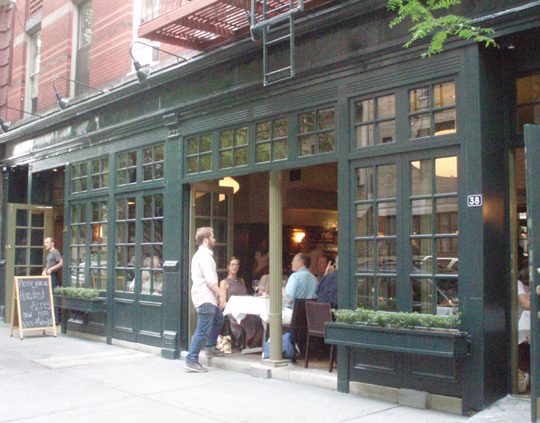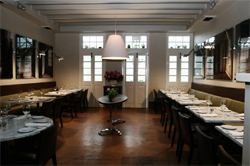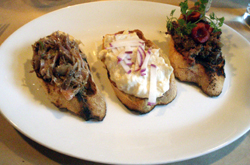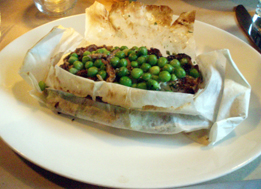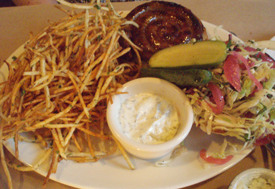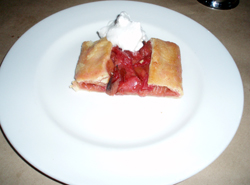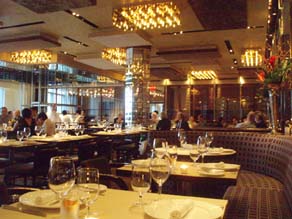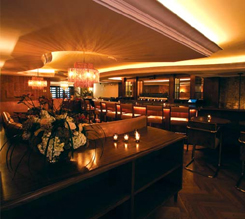Cru
 Monday, June 30, 2008 at 07:07PM
Monday, June 30, 2008 at 07:07PM Note: This is a review of Cru under Chef Shea Gallante, who left at the end of June 2009 to rejoin his former employer, David Bouley. As of November 2009, Todd Macdonald was his replacement. Prices on the wine list were slashed by 30 percent, and Macdonald’s new menu was alleged to be “easier, simpler, faster, cheaper.” That didn’t work, and as of September 2010, Cru was closed. Its replacement is Vegas transplant Lotus of Siam.
*
There’s a popular impression that traditional luxury dining is on the decline. Frank Bruni hardly ever misses an opportunity to tell us so. The trouble is, Frank can’t count—or he refuses to. If he did, he’d realize that more of these places have opened in the last four years than have closed.
 Cru is a restaurant that defies the alleged trend: it has actually become fancier. Servers that once dressed in black now wear suits. The original à la carte menu has been ditched for an $84 three-course prix fixe. In less than four years, the tasting menu has about doubled in price, from $65 to $125.
Cru is a restaurant that defies the alleged trend: it has actually become fancier. Servers that once dressed in black now wear suits. The original à la carte menu has been ditched for an $84 three-course prix fixe. In less than four years, the tasting menu has about doubled in price, from $65 to $125.
Then there’s the wine list. It boasted 65,000 bottles four years ago, over 150,000 bottles today. Most of the collection is stored in a purpose-built wine hanger in upstate New York, with supplies at the restaurant replenished daily. The sommelier said, “We buy aggressively at auction.”
As it did before, the list comes to you in two hefty volumes, each the size of a phone directory. A 1983 Hermitage was $150, a price the sommelier said was lower than that vintage attracts at auction these days. I could well believe it, as one seldom sees a 25-year-old Rhone in New York at anything less than the price of a monthly mortgage payment.
This space on lower Fifth Avenue was once considered cursed, as it played host to one failed restaurant after another. But Cru was an instant hit, and it has stayed that way, which means the owners don’t have to dumb it down or make it more casual—options its less successful brethren have had to consider.
The chef here is Shea Gallante, a former chef de cuisine at Bouley. Cru’s ascent seems almost to mirror the latter restaurant’s decline. One must wonder when someone from the next generation will crack the four-star ceiling. Given the dinner we had, Gallante looks like he could be well on the way.
The menu seems to have broadened since the early days. Frank Bruni, who awarded three stars, said it was “tilting heavily toward Italy, nodding slightly toward Spain.” Aside from a gnocchi starter—and who doesn’t serve that these days—the influences here no longer seem grounded in Italy.
I’ve been to Cru only once before, about three or four years ago. I didn’t write a review of that visit, but while I certainly recall liking Cru, I don’t recall coming away quite as impressed as this time.


The kitchen sent out a plate of canapés (above, right) while we pondered the wine list. Shortly thereafter came the amuse-bouche (above, left), a fennel panna cotta with caviar.

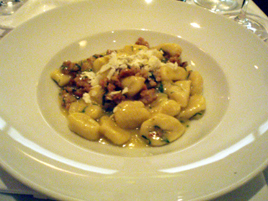
Gallante had a twist on Foie Gras “Torchon” (above, left). It came in a cigar-shaped cylinder, held together with what seemed to be a shaved cucumber. A sauce described as “peach nectar” was poured at tableside. His Potato Gnocchi (above, right) were as light as a dream, with tangy rabbit sausage, speck, pollen and spring garlic.

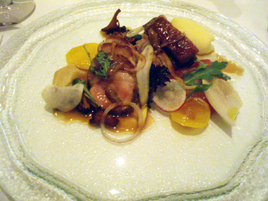
We were just as pleased with a Roasted Pekin Duck Breast (above, left), which came with grilled eggplant, leeks, poached morrels and mustard-seed jus. Cuts of Porcelet Pig (above, right)—some places would call it a trio of pig—had chanterelles, golden raisins, tomato and crisp vegetable salad.

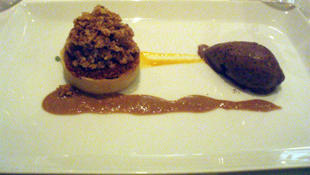
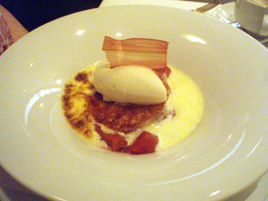
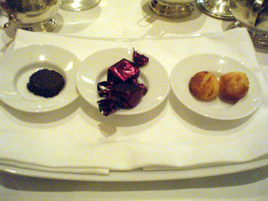
If Cru had an early failure, it was the dessert program. We love Will Goldfarb, but his wacky creations were a poor fit for a classically elegant place like Cru. Panned by just about everyone, he quickly left. The menu doesn’t note the current pastry chef, but he or she deserves to be better known.
The palate cleanser (top left) was a buttermilk sorbet with strawberry and elderflower geléee. For dessert, I had the Macadamia Nut Cheesecake Crumble (top right), which worked a lot better than it ought to, with an apricot-lemon thyme jam, hazelnut chocolate praline, and smoked chocolate chip ice cream.
Even wackier was the Poached Rhubarb Gratinèe (bottom left), a raspberry-rhubarb crips with—of all things—white asparagus ice cream. You wouldn’t expect ice cream made from a vegetable to make a great dessert, but this one did. The asparagus only lurked in the background, its aggression muted by Tahitian vanilla.
We finished with petits-fours (bottom right).
The service here is top-notch. The table settings include some of the fanciest restaurant flatware I’ve seen, made by the French manufacturer Christofle. The captain and the sommelier were both informative and had plenty to say, but never in a way that seemed intrusive or pompous. Our only complaint was that the runners who dropped off the bonus courses (amuses-bouches, etc.) were practically incomprehensible, a problem many restaurants have.
In addition to the prix-fixe and tasting menus, the captain told us about an additional option. Request five, seven, or nine courses, and the chef will cook for you. “Even I don’t know what he’ll come up with,” the captain said. I was tempted, but I figured we ought to try a smaller sample of Chef Gallante’s food first.
Based on this visit, Cru’s Shea Gallante has us convinced. Next time, we’re ready to put ourselves in his hands.
Cru (24 Fifth Avenue at Ninth Street, Greenwich Village)
Food: ***½
Service: ***½
Ambiance: ***½
Overall: ***½


